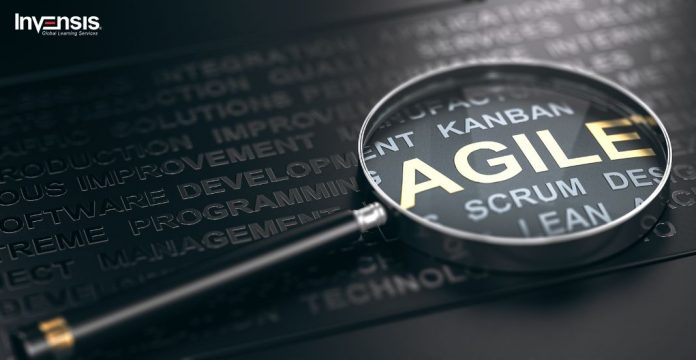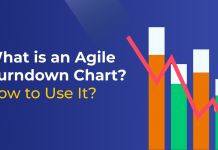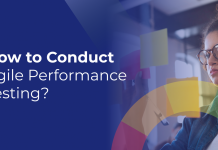
Agile has traditionally been used in smaller, more nimble development teams, but it has also recently been gaining popularity in larger organizations. We will examine the benefits and challenges of implementing Agile in large-scale projects and discuss strategies for success. Additionally, we will look at real-world examples of companies that have successfully implemented Agile in large-scale projects and the lessons they have learned. Whether you are a project manager, developer, or business leader, this blog will provide valuable insights into how Agile can improve the efficiency and effectiveness of large-scale enterprise projects.

Definition of Agile
Agile is a set of methodologies and practices for managing projects and product development that emphasizes flexibility and collaboration. The Agile approach prioritizes customer satisfaction, rapid delivery of working software, and the ability to adapt to change. Agile methodologies, such as Scrum and Kanban, use incremental and iterative work cycles, called sprints or Kanban boards, to deliver working software incrementally. This allows for continuous improvement and the ability to respond quickly to changing requirements. Agile methodologies also place a strong emphasis on teamwork and regular communication among team members.
Overview of Agile in Enterprise Projects
Agile is a project management methodology that emphasizes flexibility and collaboration. It is often used in software development but can be applied to any project. Agile in enterprise projects refers to using Agile methodologies in large, complex projects typically undertaken by large organizations. These projects often involve multiple teams and stakeholders and require a high degree of coordination and communication.
One of the key principles of Agile is the use of short iterations, called sprints, during which specific goals are set and achieved. This allows for the project to be broken down into smaller, manageable chunks and for progress to be tracked and reported regularly. Agile also emphasizes the importance of customer feedback, which is used to guide the development process and ensure that the final product meets the needs of the end users.
Some benefits of using Agile in enterprise projects include improved communication and collaboration among team members, better alignment of project goals with business objectives, and increased flexibility to adapt to changing requirements. However, it is important to note that Agile is only suitable for some projects and organizations. Therefore, careful consideration should be given to whether it is the right approach for a particular project.
Advantages of Agile in Large-scale Projects
Agile methodologies, such as Scrum and Kanban, are designed to be flexible and adaptable, which makes them well-suited for large-scale projects. Here are some detailed advantages of using agile in large-scale projects:
Flexibility
Agile methodologies allow teams to respond to changes and new requirements quickly and easily. This is particularly important for large-scale projects, which often involve multiple stakeholders with different priorities and needs. In addition, agile methodologies emphasize an iterative and incremental approach, which allows teams to easily incorporate changes as the project progresses.
Incremental Delivery
Agile methodologies prioritize delivering small, working pieces of software (or “sprints”) rather than waiting for the entire project to be completed. This allows teams to get feedback and make adjustments early on, reducing the risk of delays or missed deadlines. In addition, with this approach, teams can deliver value to the stakeholders early and continuously, which helps build trust and confidence among stakeholders.
Collaboration
Agile methodologies encourage collaboration and communication between team members and stakeholders, which is essential for managing the complexity of large-scale projects. Agile methodologies promote a collaborative approach where team members work together to deliver value, and stakeholders are involved in the decision-making process. This leads to better alignment of goals and a better understanding of the project’s requirements, which helps avoid delays and rework.
Continuous Improvement
Agile methodologies, such as Scrum, include regular retrospectives where the team can reflect on what went well and what can be improved. This allows teams to improve their processes and deliver better results continuously. Agile methodologies promote a culture of continuous improvement, which helps teams to optimize their processes and deliver better results continuously.
Visibility
Agile methodologies include frequent, transparent communication, which gives stakeholders visibility into the progress of the project and allows them to make informed decisions. Agile methodologies promote a culture of transparency, where stakeholders are kept informed of the project’s progress and can make informed decisions. This helps build trust and confidence among stakeholders, which is essential for the success of large-scale projects.
In summary, Agile methodologies offer a flexible, adaptive, and collaborative approach to managing large-scale projects. They prioritize incremental delivery, continuous improvement, and transparency, which helps teams to deliver better results and build trust among stakeholders.
Implementing Agile in Enterprise Projects
Implementing Agile in Enterprise Projects is introducing and utilizing Agile methodologies within a larger, typically more traditional business or organization. Agile is a project management approach that prioritizes flexibility, collaboration, and rapid iteration. As a result, it is particularly well-suited to projects with high uncertainty or requiring frequent adjustments in response to changing conditions. Implementing Agile in Enterprise Projects involves several steps, including:
- Assessing current project management processes: This step involves analyzing the current project management approach and identifying any areas that may need to be changed or improved to integrate Agile principles successfully
- Choosing the right Agile methodology: This step involves researching different Agile methodologies, such as Scrum, Kanban, and Lean, and determining which will best fit the organization’s specific needs and goals
- Building an Agile team: This step involves assembling a team of individuals with the necessary skills and mindset to work in an Agile environment. This includes selecting team members who can work collaboratively, think creatively, and adapt to change
- Establishing an Agile culture: This step involves creating a work environment that supports and encourages Agile principles and practices throughout the organization. This includes promoting transparency, communication, and continuous improvement
- Training and education: This step involves providing training and education to all team members on the chosen Agile methodology and how to work in an Agile environment. This helps the team members to understand the benefits, principles, and practices of Agile methodologies
- Implementing Agile practices: This step involves incorporating Agile practices, such as sprints, stand-up meetings, and retrospectives, into the project management process. This helps to ensure that the team is working in an Agile manner and that the project is on track to meet its goals.
- Continuously monitoring and improving: This step involves monitoring the progress of the project and the effectiveness of the Agile implementation and making adjustments as needed to ensure that the project is successful
- Reviewing and reporting: This step involves regularly reviewing the project’s progress and providing reports to stakeholders on the progress, deliverables, and any issues encountered
Overall, implementing Agile in Enterprise Projects is a gradual process that requires a commitment from the entire organization to change the way work is done. As a result, it may take time for the team to adjust to the new way of working and for the Agile practices to fully integrate into the organization’s culture.
Challenges of Agile in Enterprise Projects
Agile is a popular methodology for managing software development projects, but it can present challenges when implemented in an enterprise setting. These challenges include:
- Resistance to change: Agile requires a significant shift in mindset and practices, and some team members may be resistant to change, particularly those who are accustomed to traditional, more structured project management methods
- Lack of clear requirements: Agile emphasizes flexibility and adaptability, making it difficult to define clear requirements upfront. This can lead to scope creep and delays in project completion
- Difficulty in coordinating multiple teams: In an enterprise setting, multiple teams may work on different parts of the same project, making coordination and communication more difficult. This can lead to conflicting priorities and delays in project completion.
- Limited visibility into progress: Agile methods can make it harder to track progress, as the focus is on delivering working software incrementally rather than on specific deliverables. This can make it difficult for stakeholders to assess progress and make decisions
- Difficulty in measuring success: Agile methods can make it harder to measure success in terms of traditional metrics such as cost and schedule. This can make it difficult for stakeholders to assess the value of the project and make funding decisions
- Scaling Agile: Scaling Agile methodologies and practices to large enterprise projects can be a significant challenge. Agile methodologies are often best suited for small, cross-functional teams and may be less effective when applied to large, complex projects with multiple teams and stakeholders
- Lack of governance and oversight: Agile methodologies place a lot of autonomy and ownership on individual teams, but this can also lead to a lack of governance and oversight, which can be a problem in large organizations. This can lead to confusion, delays, and a lack of accountability
Despite these challenges, Agile can still be effective in enterprise projects with the right mindset and approach and with the right tools, methodologies, and frameworks. It is important to understand the project objectives, stakeholders, and expectations clearly and to have the plan to address the challenges and risks.
Successful Agile Case Studies in Enterprise Projects
Case Study 1: Agile Implementation in ING Bank
One example of a successful Agile implementation in an enterprise project is the case of ING Bank, a major financial institution. ING Bank was facing increasing competition from online and mobile banking platforms and needed to improve its ability to respond quickly to customer demands and market changes.
To address this challenge, ING Bank implemented Agile methodologies across its entire organization, focusing on customer-centric development. This involved training all employees on Agile principles and practices and forming cross-functional teams to work on different aspects of the business.
The implementation was phased over several months, starting with a pilot program in one of the bank’s business units. This pilot successfully improved customer satisfaction and increased the speed of product development and was subsequently rolled out to the rest of the organization.
As a result of the Agile implementation, ING Bank improved its ability to respond to customer demands and market changes quickly and saw a significant increase in customer satisfaction. The bank also experienced a significant increase in the speed of product development and was able to release new products and features more quickly than before.
Case Study 2: Agile Implementation in Spotify
Another example of successful Agile implementation in an enterprise project is the case of Spotify, the music streaming service, which implemented Scaled Agile Framework (SAFe) to manage its rapid growth and global expansion. Spotify adopted SAFe, a methodology for scaling Agile development practices, to stay ahead of the curve as it expanded into new markets. This approach helped Spotify to improve its ability to deliver features and products to customers faster and more efficiently. The result was that the company could respond better to market changes and customer needs.
Conclusion
In conclusion, using Agile methodology in large-scale enterprise projects can bring significant benefits such as increased flexibility, improved communication, and faster delivery of high-quality products. However, successfully implementing Agile in a large-scale enterprise environment requires a clear understanding of the methodology, strong leadership, and a willingness to adapt to change. Additionally, it’s important to note that Agile is not a one-size-fits-all solution and should be tailored to the organization’s and project’s specific needs. Nevertheless, with the right approach and mindset, Agile can help organizations achieve their goals and stay competitive in today’s fast-paced business environment.
Take Your Agile Project Management Skills to the Next Level with AgilePM Certification. Earning an Agile project management certification adds value to your resume and helps you take a step further in managing projects with agility. So, what are you waiting for? Enroll with Invensis Learning Agile Project Management certifications and gain a competitive edge.
Glossary
- Agile: Agile is a methodology for managing and completing projects emphasizing flexibility, collaboration, and customer satisfaction
- Scrum: A specific framework for implementing Agile, which uses small teams, regularly scheduled meetings, and incremental progress toward a final goal
- Sprint: A short, time-boxed period (typically 2-4 weeks) during which a specific set of tasks are completed as part of the overall project
- Product Owner: A person responsible for representing the customer’s interests and ensuring that the project delivers value to the end user
- Scrum Master: A person responsible for facilitating the Scrum process and ensuring that the team follows the Agile principles
- Sprint Retrospective: A meeting held at the end of each sprint to review the team’s progress and identify areas for improvement
- Backlog: A prioritized list of tasks that must be completed as part of the project.
- Kanban: A method for visualizing and managing workflows, often used in conjunction with Agile to help teams prioritize and track tasks
- Continuous Integration: A software development practice where code is frequently integrated and tested to minimize integration issues
- DevOps: A set of practices that emphasizes collaboration and communication between development and operations teams to improve the speed and quality of software releases
————————————————————————————————————————————-
Organize Corporate Group Six Sigma Certification training for your teams around the world
Invensis learning provides In-person and live virtual instructor-led corporate training program customized for enterprise teams who wish to train their employees on specific aspects of their job processes or responsibilities. The corporate training by our expert certified trainers will enhance your learning curve and enable your teams to utilize their skills to meet industry standards.
- Experienced & Industry Specific Trainers
- Lifetime LMS access
- Deliver sessions across continents via In-Person/ Virtual Instructor-Led Training
- Customized Training
————————————————————————————————————————————-





















